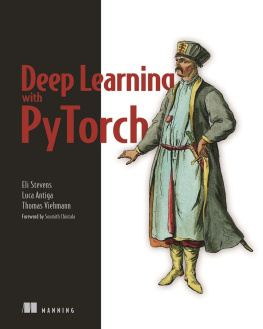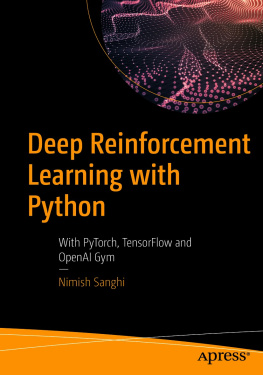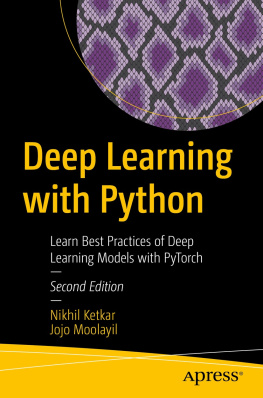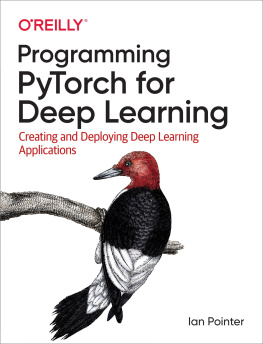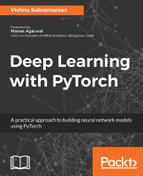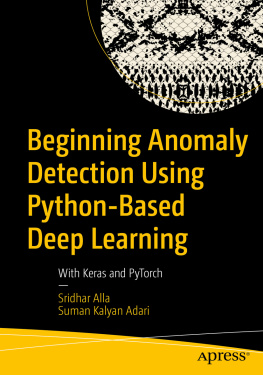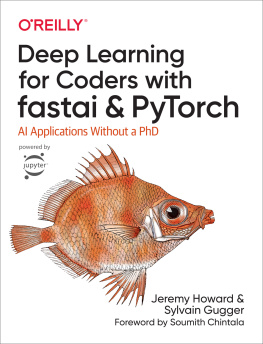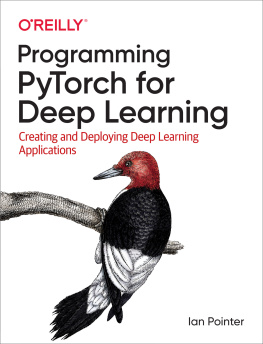
Deep Learning with PyTorch
Eli Stevens, Luca Antiga, and Thomas Viehmann
Foreword by Soumith Chintala
To comment go to liveBook

Manning
Shelter Island
For more information on this and other Manning titles go to
manning.com
Copyright
For online information and ordering of these and other Manning books, please visit manning.com. The publisher offers discounts on these books when ordered in quantity.
For more information, please contact
Special Sales Department
Manning Publications Co.
20 Baldwin Road
PO Box 761
Shelter Island, NY 11964
Email: orders@manning.com
2020 by Manning Publications Co. All rights reserved.
No part of this publication may be reproduced, stored in a retrieval system, or transmitted, in any form or by means electronic, mechanical, photocopying, or otherwise, without prior written permission of the publisher.
Many of the designations used by manufacturers and sellers to distinguish their products are claimed as trademarks. Where those designations appear in the book, and Manning Publications was aware of a trademark claim, the designations have been printed in initial caps or all caps.
Recognizing the importance of preserving what has been written, it is Mannings policy to have the books we publish printed on acid-free paper, and we exert our best efforts to that end. Recognizing also our responsibility to conserve the resources of our planet, Manning books are printed on paper that is at least 15 percent recycled and processed without the use of elemental chlorine.

| Manning Publications Co. 20 Baldwin Road Technical PO Box 761 Shelter Island, NY 11964 |
Development editor: | Frances Lefkowitz |
Technical development editor: | Arthur Zubarev |
Review editor: | Ivan Martinovi |
Production editor: | Deirdre Hiam |
Copyeditor: | Tiffany Taylor |
Proofreader: | Katie Tennant |
Technical proofreader: | Kostas Passadis |
Typesetter: | Gordan Salinovi |
Cover designer: | Marija Tudor |
ISBN: 9781617295263
1 2 3 4 5 6 7 8 9 10 - SP - 24 23 22 21 20 19
dedication
To my wife (this book would not have happened without her invaluable support and partnership), my parents (I would not have happened without them), and my children (this book would have happened a lot sooner but for them).
Thank you for being my home, my foundation, and my joy.
--Eli Stevens
Same :-) But, really, this is for you, Alice and Luigi.
--Luca Antiga
To Eva, Rebekka, Jonathan, and David.
--Thomas Viehmann
front matter
foreword
When we started the PyTorch project in mid-2016, we were a band of open source hackers who met online and wanted to write better deep learning software. Two of the three authors of this book, Luca Antiga and Thomas Viehmann, were instrumental in developing PyTorch and making it the success that it is today.
Our goal with PyTorch was to build the most flexible framework possible to express deep learning algorithms. We executed with focus and had a relatively short development time to build a polished product for the developer market. This wouldnt have been possible if we hadnt been standing on the shoulders of giants. PyTorch derives a significant part of its codebase from the Torch7 project started in 2007 by Ronan Collobert and others, which has roots in the Lush programming language pioneered by Yann LeCun and Leon Bottou. This rich history helped us focus on what needed to change, rather than conceptually starting from scratch.
It is hard to attribute the success of PyTorch to a single factor. The project offers a good user experience and enhanced debuggability and flexibility, ultimately making users more productive. The huge adoption of PyTorch has resulted in a beautiful ecosystem of software and research built on top of it, making PyTorch even richer in its experience.
Several courses and university curricula, as well as a huge number of online blogs and tutorials, have been offered to make PyTorch easier to learn. However, we have seen very few books. In 2017, when someone asked me, When is the PyTorch book going to be written? I responded, If it gets written now, I can guarantee that it will be outdated by the time it is completed.
With the publication of Deep Learning with PyTorch, we finally have a definitive treatise on PyTorch. It covers the basics and abstractions in great detail, tearing apart the underpinnings of data structures like tensors and neural networks and making sure you understand their implementation. Additionally, it covers advanced subjects such as JIT and deployment to production (an aspect of PyTorch that no other book currently covers).
Additionally, the book covers applications, taking you through the steps of using neural networks to help solve a complex and important medical problem. With Lucas deep expertise in bioengineering and medical imaging, Elis practical experience creating software for medical devices and detection, and Thomass background as a PyTorch core developer, this journey is treated carefully, as it should be.
All in all, I hope this book becomes your extended reference document and an important part of your library or workshop.
Soumith Chintala
Cocreator of PyTorch
preface
As kids in the 1980s, taking our first steps on our Commodore VIC 20 (Eli), the Sinclair Spectrum 48K (Luca), and the Commodore C16 (Thomas), we saw the dawn of personal computers, learned to code and write algorithms on ever-faster machines, and often dreamed about where computers would take us. We also were painfully aware of the gap between what computers did in movies and what they could do in real life, collectively rolling our eyes when the main character in a spy movie said, Computer, enhance.
Later on, during our professional lives, two of us, Eli and Luca, independently challenged ourselves with medical image analysis, facing the same kind of struggle when writing algorithms that could handle the natural variability of the human body. There was a lot of heuristics involved when choosing the best mix of algorithms that could make things work and save the day. Thomas studied neural nets and pattern recognition at the turn of the century but went on to get a PhD in mathematics doing modeling.
When deep learning came about at the beginning of the 2010s, making its initial appearance in computer vision, it started being applied to medical image analysis tasks like the identification of structures or lesions on medical images. It was at that time, in the first half of the decade, that deep learning appeared on our individual radars. It took a bit to realize that deep learning represented a whole new way of writing software: a new class of multipurpose algorithms that could learn how to solve complicated tasks through the observation of data.
but his career pointed him in other directions, and he found other, earlier deep learning frameworks a bit too laborious to get enthusiastic about using them for a hobby project.
Next page
